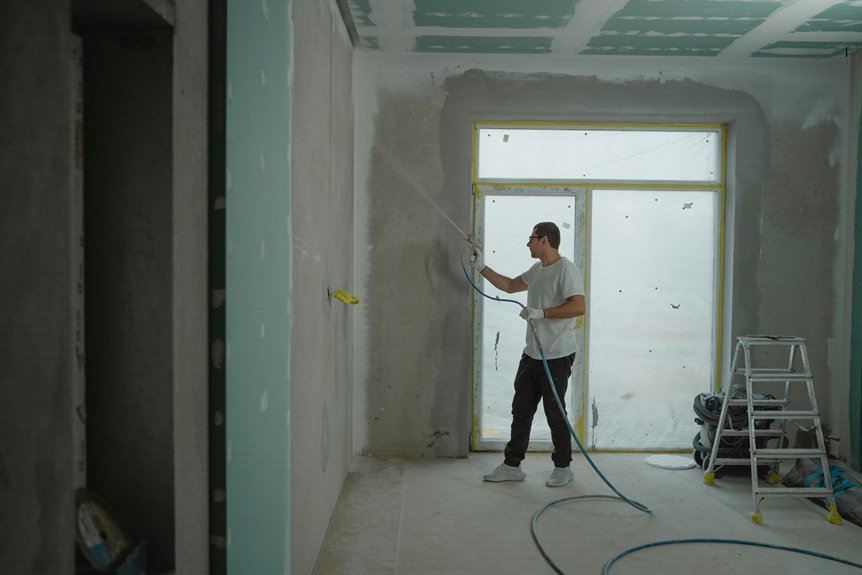Keeping your home in good shape doesn’t have to be a chore. By tackling a few simple maintenance tasks, you can enhance safety and efficiency. From checking smoke detector batteries to cleaning gutters, these easy steps are manageable for anyone. Plus, staying on top of them can save you money and hassle down the line. Curious about which tasks you might be neglecting? Let’s explore these essential home maintenance tips.
Key Takeaways
- Check and replace smoke detector batteries every 6 to 12 months for safety and functionality.
- Clean gutters at least twice a year to prevent water damage and ensure proper drainage.
- Replace air filters every 3 months to maintain air quality and HVAC efficiency.
- Test carbon monoxide detectors monthly and replace every 5 to 7 years for safety.
- Inspect and maintain window seals semi-annually to enhance energy efficiency and reduce costs.
Check and Replace Smoke Detector Batteries

One essential home maintenance task you shouldn’t overlook is checking and replacing your smoke detector batteries.
These batteries typically have a lifespan of six months to a year, so it’s important to stay on top of this task. To guarantee your smoke detectors are functioning properly, test them monthly.
Smoke detector batteries last six months to a year; test them monthly to ensure safety and functionality.
When you replace the batteries, make sure to use the recommended type for your unit. Regular smoke detector maintenance not only keeps your home safe but also gives you peace of mind.
Set a reminder, and don’t let this simple yet critical task slip through the cracks—it could save lives.
Clean Out Your Gutters
Cleaning out your gutters at least twice a year is crucial for maintaining your home’s integrity. Clogged gutters can lead to serious water damage.
Here are some effective gutter cleaning techniques and maintenance tips to keep in mind:
- Use a sturdy ladder for safe access.
- Wear gloves to protect your hands from debris.
- Clear out leaves and muck using a trowel.
- Flush with water to guarantee proper drainage.
Change Air Filters
Changing your air filters regularly is essential for maintaining a healthy home environment and guaranteeing your HVAC system runs efficiently.
Regularly changing your air filters is crucial for a healthy home and optimal HVAC performance.
There are various air filter types, including HEPA, pleated, and fiberglass, so choose one that suits your needs. Check your filters every month and replace them every 3 months or as recommended.
When installing a new filter, make sure the arrows on the filter frame point toward the airflow direction. This simple task not only improves air quality but also enhances your system’s performance.
Don’t forget to keep a few extra filters on hand for quick replacements!
Test Your Carbon Monoxide Detectors
Carbon monoxide is a silent killer, making it essential to test your detectors regularly.
You should check them at least once a month and replace batteries as needed to guarantee they function properly.
Plus, placing them in the right spots can make all the difference in keeping your home safe.
Importance of Carbon Monoxide
While you mightn’t think about it often, ensuring your carbon monoxide detectors are functioning properly is essential for your safety.
Carbon monoxide is a colorless, odorless gas that can be deadly. Knowing common carbon monoxide sources helps you stay vigilant:
- Gas appliances
- Vehicles running in an attached garage
- Faulty furnaces
- Generators used indoors
Be aware of carbon monoxide symptoms, which can include headaches, dizziness, and nausea.
Regularly testing your detectors can save lives. Don’t wait for a warning—make it a habit to check them often for peace of mind and safety in your home.
Testing Frequency Guidelines
To guarantee your safety, testing your carbon monoxide detectors at least once a month is essential.
Stick to a testing schedule that’s easy to remember, like the first day of each month. This frequency recommendation helps guarantee your detectors function properly, providing peace of mind.
If you hear a chirping sound or your detector’s indicator light signals a problem, replace the batteries immediately.
Don’t forget to check the expiration date on your detectors as well; most need replacing every 5 to 7 years.
Regularly checking your detectors can save lives, so make it a priority in your home maintenance routine!
Proper Detector Placement
Properly placing your carbon monoxide detectors can make all the difference in guaranteeing your home’s safety.
Follow these installation guidelines to maximize their effectiveness:
- Install detectors near sleeping areas for immediate alerts.
- Avoid placing them near windows or vents, which can affect readings.
- Use appropriate detector types, such as plug-in or battery-operated, based on your home’s layout.
- Regularly check and test detectors to confirm they function properly.
Inspect and Seal Windows and Doors
Windows and doors are essential gateways to your home, offering both access and insulation. To improve energy efficiency, inspect them regularly for gaps or worn weather stripping. Sealing these areas helps maintain your home’s temperature and lowers energy bills.
Here’s a quick checklist to guide you:
| Task | Frequency |
|---|---|
| Inspect seals | Every 6 months |
| Replace weather stripping | As needed |
| Clean frames | Seasonal |
| Test window locks | Annually |
Taking these steps guarantees your windows and doors do their job efficiently, enhancing your home’s comfort and reducing costs.
Flush Your Water Heater
Flushing your water heater is an essential maintenance task that can prolong its lifespan and improve efficiency.
Over time, sediment buildup can affect performance and lead to costly repairs. Regular flushing helps prevent these issues.
Here’s how to do it:
- Turn off the power or gas supply.
- Connect a garden hose to the drain valve.
- Open the valve and let the water flow out.
- Close the valve and refill the tank.
Maintain Your Lawn and Garden

Keeping your lawn and garden in top shape is easier than you might think.
You’ll learn the essentials of mowing, the importance of pruning, and how to care for your plants throughout the seasons.
With a little effort, you can create an outdoor space that’s both beautiful and thriving.
Lawn Mowing Basics
Mowing your lawn regularly is one of the most essential tasks for maintaining a healthy garden. Proper lawn care keeps your grass lush and vibrant.
Here are some basic mowing techniques to follow:
- Mow when the grass is dry to avoid clumping.
- Keep your mower blades sharp for a clean cut.
- Adjust the cutting height according to the season.
- Change up your mowing pattern to promote even growth.
Pruning and Trimming Tips
Pruning and trimming are essential for maintaining a healthy and attractive garden, and they can make a significant difference in the overall appearance of your landscape.
Use proper pruning techniques to remove dead or diseased branches, promoting growth and airflow. For trimming, invest in quality trimming tools like shears and hedge trimmers to shape your plants neatly.
Always cut at a slight angle to prevent water accumulation, and avoid cutting too much at once—less is more!
Regular maintenance keeps your garden vibrant and encourages blooming. With the right approach, you’ll enhance your outdoor space effortlessly.
Happy gardening!
Seasonal Plant Care Guide
As the seasons change, so do the needs of your lawn and garden, making it essential to adapt your care routine accordingly.
Here’s a quick guide to seasonal planting and plant watering:
- Spring: Begin with soil preparation and early planting; guarantee consistent watering.
- Summer: Focus on deep watering and mulch to retain moisture; deadhead flowers.
- Fall: Plant perennials and prepare your garden for winter; reduce watering.
- Winter: Protect vulnerable plants with mulch; check for frost damage.
Conclusion
By tackling these seven simple home maintenance tasks, you’re not just keeping your home safe and efficient; you’re also saving yourself time and money in the long run. Set reminders to stay on track, and don’t hesitate to ask for help if needed. Remember, a little effort now can prevent bigger issues later. So get started today, and enjoy the peace of mind that comes with knowing your home is well cared for!

